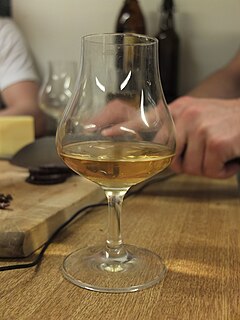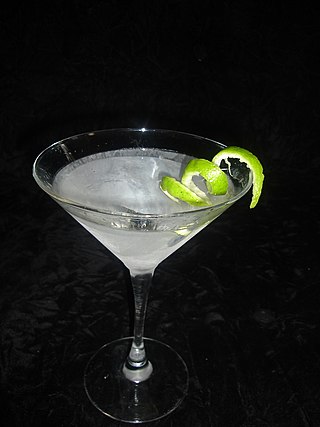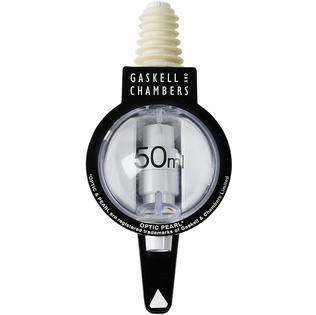
Scotch whisky is malt whisky or grain whisky, made in Scotland.

Whisky or whiskey is a type of distilled alcoholic beverage made from fermented grain mash. Various grains are used for different varieties, including barley, corn, rye, and wheat. Whisky is typically aged in wooden casks, which are typically made of charred white oak. Uncharred white oak casks previously used for the aging of sherry are also sometimes used.

Single malt Scotch refers to single malt whisky made in Scotland. To qualify for this category, a whisky must have been distilled at a single distillery using a pot still distillation process and made from a mash of malted barley. Therefore, a single malt means that the whisky has not been blended elsewhere with whisky from other distilleries. As with any Scotch whisky, a single malt Scotch must be distilled in Scotland and matured in oak casks in Scotland for at least three years, although most single malts are matured longer.

Single malt whisky is malt whisky from a single distillery.
A blended whiskey is the product of blending different types of whiskeys and sometimes also neutral grain spirits, colorings, and flavorings. It is generally the product of mixing one or more higher-quality straight or single malt whiskey with less expensive spirits and other ingredients. This typically allows for a lower priced finished product, although expensive "premium" varieties also exist.

A pot still is a type of distillation apparatus or still used to distill liquors such as whisky or brandy. In modern (post-1850s) practice, they are not used to produce rectified spirit, because they do not separate congeners from ethanol as effectively as other distillation methods. Pot stills operate on a batch distillation basis. Traditionally constructed from copper, pot stills are made in a range of shapes and sizes depending on the quantity and style of spirit desired.

In botany, a bract is a modified or specialized leaf, especially one associated with a reproductive structure such as a flower, inflorescence axis or cone scale. Bracts are often different from foliage leaves. They may be smaller, larger, or of a different color, shape, or texture. Typically, they also look different from the parts of the flower, such as the petals or sepals. A plant having bracts is referred to as bracteate or bracteolate, while one that lacks them is referred to as ebracteate and ebracteolate, without bracts.

A barrel or cask is a hollow cylindrical container with a bulging center, longer than it is wide. They are traditionally made of wooden staves and bound by wooden or metal hoops. The word vat is often used for large containers for liquids, usually alcoholic beverages; a small barrel or cask is known as a keg.

Liquor is an alcoholic drink produced by distillation of grains, fruits, vegetables, or sugar, that have already gone through alcoholic fermentation. Other terms for liquor include: spirit drink, distilled beverage or hard liquor. The distillation process concentrates the liquid to increase its alcohol by volume. As liquors contain significantly more alcohol (ethanol) than other alcoholic drinks, they are considered 'harder'; in North America, the term hard liquor is sometimes used to distinguish distilled alcoholic drinks from non-distilled ones, whereas the term spirits is more common in the UK. Some examples of liquors include vodka, rum, gin, and tequila. Liquors are often aged in barrels, such as for the production of brandy and whiskey, or are infused with flavorings to form a flavored liquor such as absinthe.
Killyloch is a malt whisky which was distilled at the Glenflagler Malt Distillery and was first distilled and bonded in February 1965.

The phenomenon called tears of wine is manifested as a ring of clear liquid, near the top of a glass of wine, from which droplets continuously form and drop back into the wine. It is most readily observed in a wine which has a high alcohol content. It is also referred to as wine legs, fingers, curtains, church windows, or feet.

Lao-Lao is a Laotian rice whisky produced in Laos. Along with Beerlao, lao-Lao is a staple drink in Laos.

Various unique terminology is used in bartending.
The Kininvie distillery is a distillery in Dufftown, Moray, which produces single malt Scotch whisky. The distillery is owned by William Grant & Sons and the product from the distillery is used in their blended malt and blended whisky brands.

German whisky is a distilled beverage produced in Germany made from grains traditionally associated with the production of whisky. The distillation of German-made whisky is a relatively recent phenomenon having only started in the last 30 years. The styles produced resemble those made in Ireland, Scotland and the United States: single malts, blends, and bourbon styles. There is no standard spelling of German whiskies with distilleries using both "whisky" and "whiskey" and one even using "Whesskey", a play on the word whisky and Hessen, the state in which it is produced. There are currently 23 distilleries in Germany producing whisky.

Alcoholic spirits measures are instruments designed to measure exact amounts or shots of alcoholic spirits.

Single pot still whiskey is a style of Irish whiskey made by a single distillery from a mixed mash of malted and unmalted barley distilled in a pot still. Somewhat similar to single malt whiskey, the style was defined by its inclusion of unmalted raw barley in the mash in addition to malt. However, small amounts of raw oats or wheat may have been used at times. This unmalted component is said to give the pot still whiskey a "spicier bristle" and "thicker texture" than the otherwise similar malt whiskeys. If the whiskey is not distilled completely on the site of a single distillery, then it may be termed pot still whiskey but not single pot still whiskey.

Buckwheat whisky is a type of distilled alcoholic beverage made entirely or principally from buckwheat. It is produced in the Brittany region of France and in the United States. Soba shōchū is a similar but weaker beverage produced in Japan. Liquor produced from the distillation of buckwheat honey is also sometimes sold as buckwheat whisky or whiskey, though technically this is a type of distilled mead.













